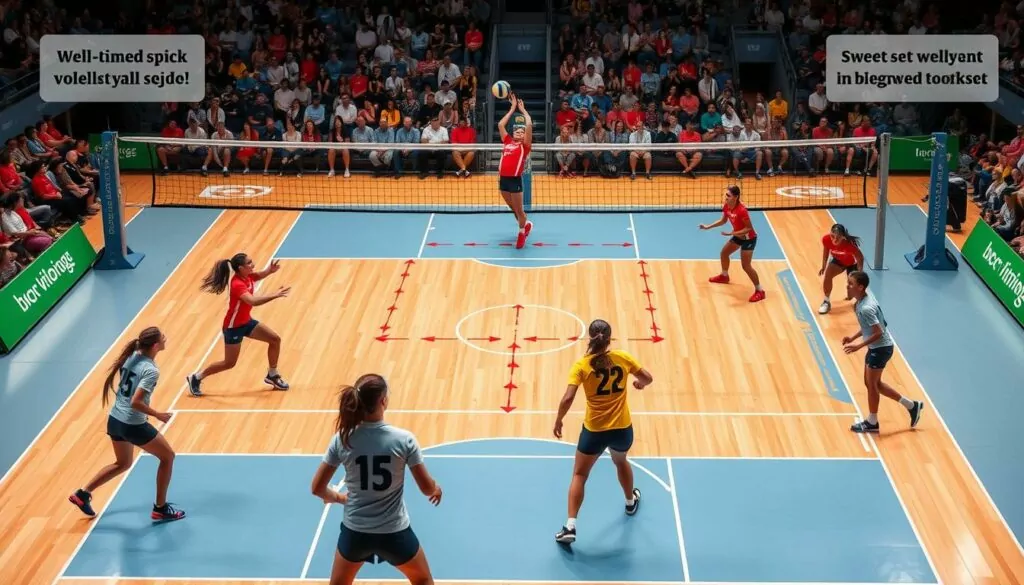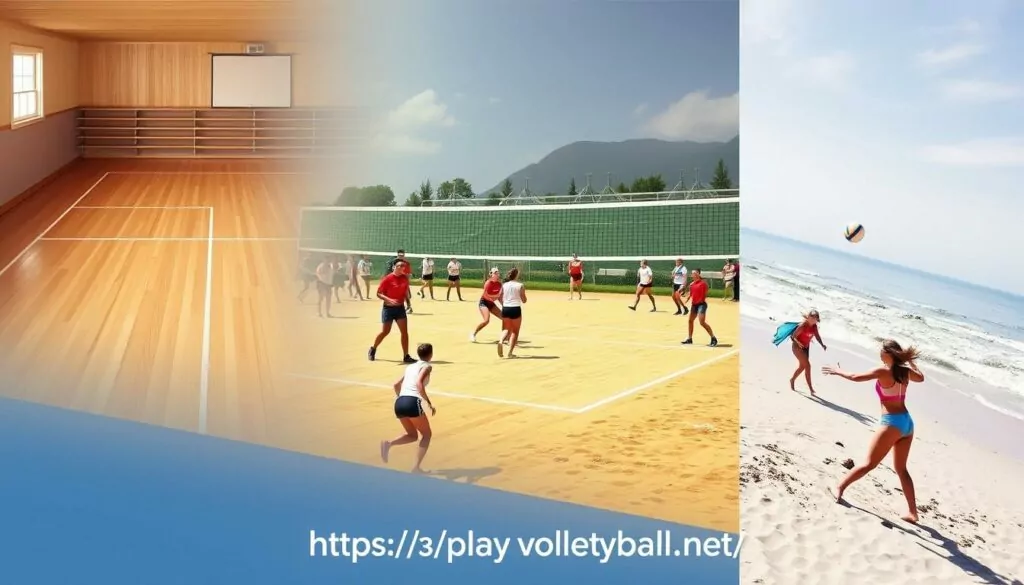As I stepped onto the volleyball court, my heart raced. The ball hitting the floor, the crowd cheering, and my teammates by my side brought back memories. Volleyball tests your limits, combining strength, strategy, and mental strength. Mastering the game brings unmatched joy.
In this article, we’ll explore key volleyball strategies to improve your game. We’ll cover everything from basic stance to advanced techniques like spiking and blocking. You’ll learn to serve accurately, work well with your team, and stay focused under pressure. By the end, you’ll know how to dominate the game and lead your team to win.
Key Takeaways
- Develop a deep understanding of fundamental volleyball techniques and positioning.
- Cultivate effective communication and teamwork strategies to enhance on-court coordination.
- Master serving techniques to gain a competitive advantage and disrupt the opposition.
- Employ defensive strategies to counter the opponent’s attacks and create scoring opportunities.
- Leverage offensive tactics to orchestrate powerful attacks and capitalize on weaknesses.
Understanding the Basics of Volleyball
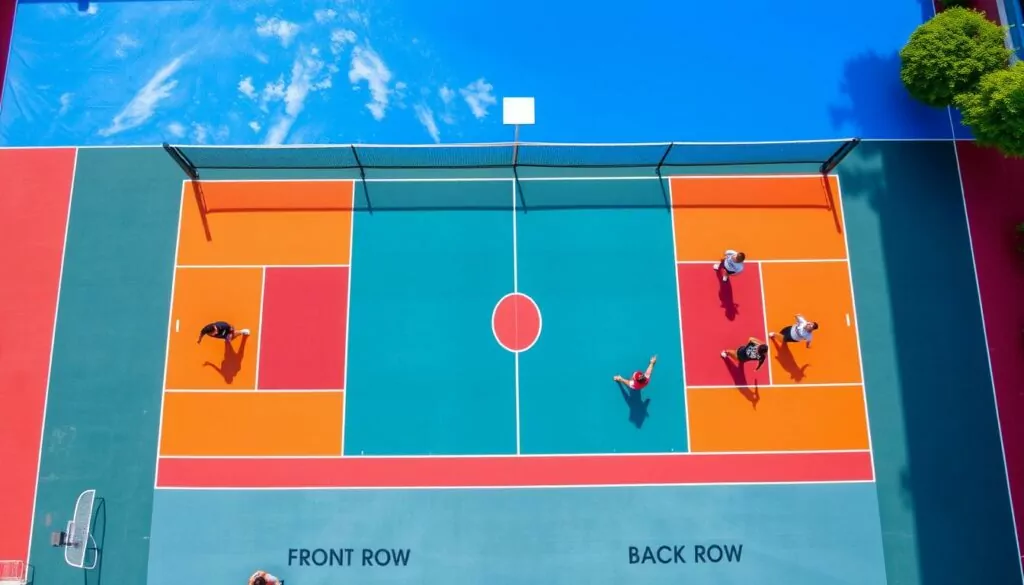
To become a great volleyball player, you need to know the basics. Start by standing with your feet shoulder-width apart. Keep your knees slightly bent and your weight on your toes. This stance helps you move quickly and react fast.
The Objective of the Game
The main goal in volleyball is to score points by making the ball land on the other team’s side. You can touch the ball up to three times before sending it over the net. The team that reaches 25 points first wins a set. The team that wins the most sets in a match wins the game.
Key Positions on the Court
- Setter: Directs the ball to the hitters to set up plays.
- Outside Hitter: Scores points with powerful spikes from the left side.
- Middle Blocker: Blocks the opponents’ attacks at the net.
- Opposite Hitter: Attacks from the right side, helping the outside hitter.
- Libero: Specializes in passing and digging the ball.
Scoring System Explained
Matches are divided into three to five sets. The team that wins two sets first wins the match. If a team commits a foul, like stepping on the service line, the other team gets a point.
| Match Type | Set Requirements |
|---|---|
| Best of 3 Sets | 2 sets won at 25 points |
| Best of 5 Sets | 3 sets won at 25 points, 5th set at 15 points |
Knowing the basics of volleyball is essential. It helps you develop advanced skills and strategies. Mastering these basics is key to success on the court.
Importance of Communication on the Court

Good communication is key for a winning volleyball team. It makes sure everyone moves together, cuts down mistakes, and builds trust. Players use clear calls and hand signals to talk without shouting over the noise, keeping the game smooth.
Building Trust with Teammates
Trust is vital for success on the court. When teammates trust each other, they can guess what the other will do. This leads to better teamwork and fewer mistakes. Drills like pepper or synchronized blocking help build trust and understanding.
Effective Signals and Calls
- Good communication can make play 25% quicker and more effective.
- Teams that listen well have 30% fewer mix-ups during games.
- Understanding different communication styles can improve team unity by 10%.
- Staying calm under pressure can cut down on mistakes by 15%.
Creating a culture of team communication, volleyball signals, and on-court trust can boost a team’s performance. Clear and simple communication is the heart of a well-working volleyball team.
“Communication is the key to unlocking the full team communication. When players trust each other and work in sync, the game becomes a seamless dance of strategy and skill.”
Good communication is more than just calling out plays. It’s about understanding each other and knowing what to expect. By working on communication skills, teams can get a big edge on the court.
Serving Techniques to Gain an Advantage
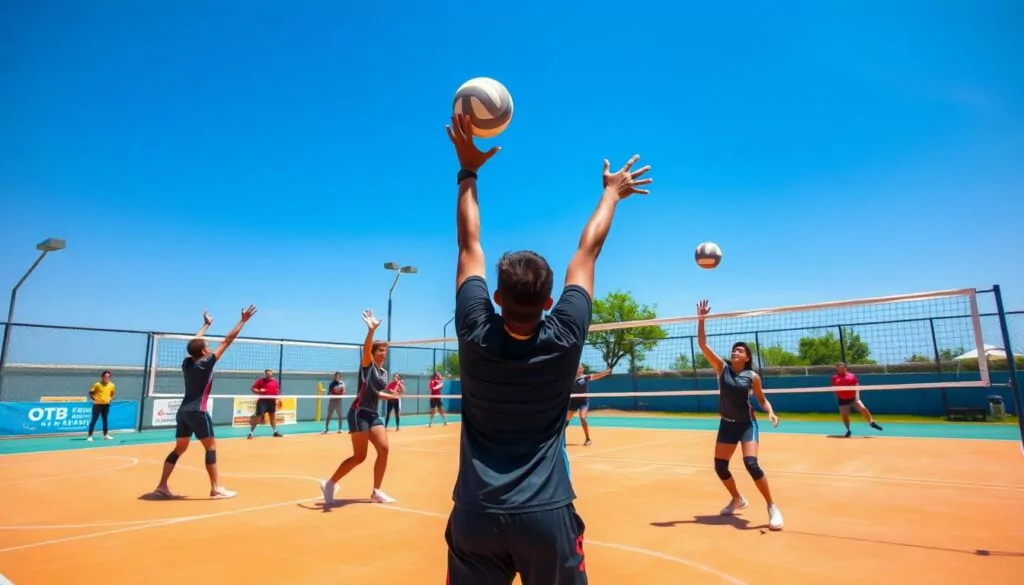
In volleyball, the serve is the first chance to attack. It can set the game’s tone. By mastering different serving techniques, players can keep opponents guessing and gain an edge. Techniques like the jump serve and the float serve can be game-changers.
Types of Serves
The overhand serve is the basic, needing a steady toss and smooth arm swing. The float serve’s unpredictable path can mess up the opponent’s timing. The topspin serve’s sharp angle is a challenge. And the jump serve’s power can change the game if done right.
Tips for a Powerful Serve
- Develop a consistent ball toss for a reliable point of contact.
- Focus on leg drive and core engagement to generate power.
- Experiment with different grips and arm swings to find your sweet spot.
- Practice serving to specific targets on the court to improve accuracy.
Analyzing Opponent’s Weaknesses
To dominate the serve, study your opponents’ habits and weaknesses. Watch their passing, positioning, and how they communicate. Then, aim your serves at their weak spots, forcing them out of rhythm and opening up scoring chances for your team.
“Mastering the art of serving is not just about power; it’s about precision, strategy, and the ability to read your opponents.”
By mixing up your serves and spotting your opponents’ weaknesses, you can boost your serving skills. This will give you a big advantage on the volleyball court.
Defensive Strategies to Stop Opponents

Effective volleyball defense needs agility, anticipation, and precise technique. The libero is key, boosting the team’s reflexes and understanding the game’s pace. Learning to dig and pass is essential, turning strong attacks into chances to counterattack.
The Role of Libero
The libero is a defensive expert, playing a critical role in the team’s defense. They are known for their great court coverage and ball-handling. Liberos act as the team’s last defense, ready to make key digs.
They also communicate well with teammates, helping the team switch from defense to offense smoothly.
Digging and Passing Techniques
Digging is about catching and controlling powerful spikes. Players must stay low, arms ready, and aim the ball up to the setter. Good passing is also key, setting up the team’s offense.
By keeping a stable base and consistent contact, players can send the ball to the setter. This helps the team launch a strong counterattack.
Formations for Strong Defense
- Use defensive formations that cover the court well and allow for quick changes.
- Choose specific positions, like the 6-2 or 5-1, to improve defense.
- Work with the libero for smooth coverage and communication.
By focusing on the libero, improving digging and passing, and using smart formations, teams can build a strong defense. This defense can disrupt the opponent’s flow and open up scoring chances.
Offensive Strategies for Effective Play
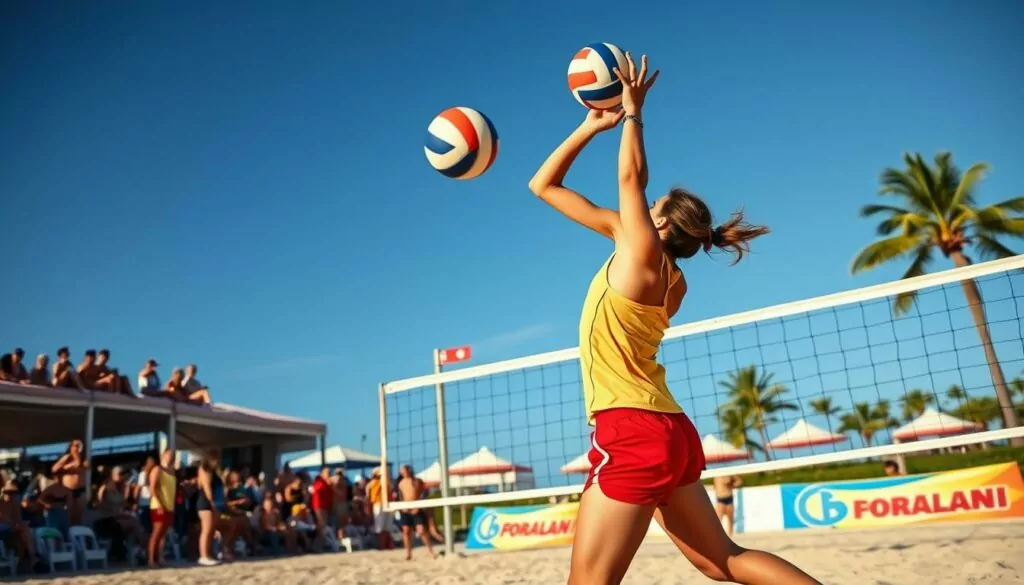
As a volleyball player, I’ve learned that a strong offense is key to winning. The spike is a standout move that can surprise the other team and score points. To spike well, I work on my approach, jump, and swing timing.
I use my core and shoulder strength to hit the ball hard and fast. This aims to overwhelm the blockers.
There are many ways to attack the ball, not just the spike. Quick hits, slides, and back row attacks keep the other team guessing. The setter is also key, needing quick reflexes and good spatial awareness to set up the attack.
Setting Up Attacks
The setter is often the first to set up the attack. They watch the game closely and know when to pass the ball to the right hitter. A good setter can spot weaknesses in the defense and set up the attack perfectly.
Types of Attacks
- Quick Hits: These fast, low-set attacks aim to surprise the blockers with speed.
- Slides: These use the middle blocker’s momentum for a quick, angled attack.
- Back Row Attacks: These come from the back row and add surprise to the offense.
Timing and Placement of Hits
The timing and where I hit the ball are very important. I adjust my swing based on the set I get. By watching the blockers, I can place my shots to find open spaces and score points.
“Offensive efficiency is the key to winning in volleyball. By mastering a variety of attack strategies, you can keep the opposing team on their toes and dominate the game.”
Understanding Rotations and Positions
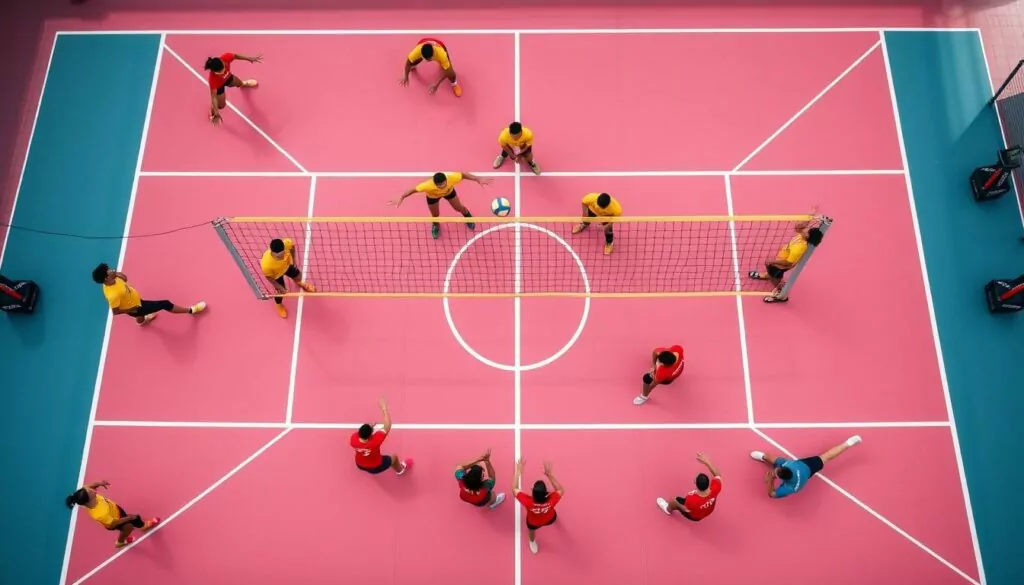
In volleyball, knowing where to stand and how to move is key. It helps keep the court covered, offense strong, and defense solid. Learning the basics and the benefits of different rotations can really help a team play better.
Basic Rotation Rules
When a team wins a rally, they move clockwise. Each player shifts one spot to the right. This makes sure every player gets a turn to serve. It keeps the court balanced and players in their right spots.
The server stands alone, serving from behind the end-line. They don’t follow the rotation pattern.
Advantages of Specific Rotations
- Using player strengths: Teams can focus on their best players in certain spots.
- Targeting opponent weaknesses: Knowing the other team’s moves helps plan the best attack.
- Keeping the court covered: Good rotations help players defend and set up plays.
Getting good at volleyball rotations and positions is essential. Knowing the rules and the benefits of different strategies can make a team stronger. It gives them an edge in the game.
| Volleyball Rotation Patterns | Percentage of Front-Row Players | Percentage of Back-Row Players |
|---|---|---|
| Traditional Rotation | 50% | 50% |
| Specialized Rotations | Varies based on team strategy | Varies based on team strategy |
Analyzing Opponent Tactics
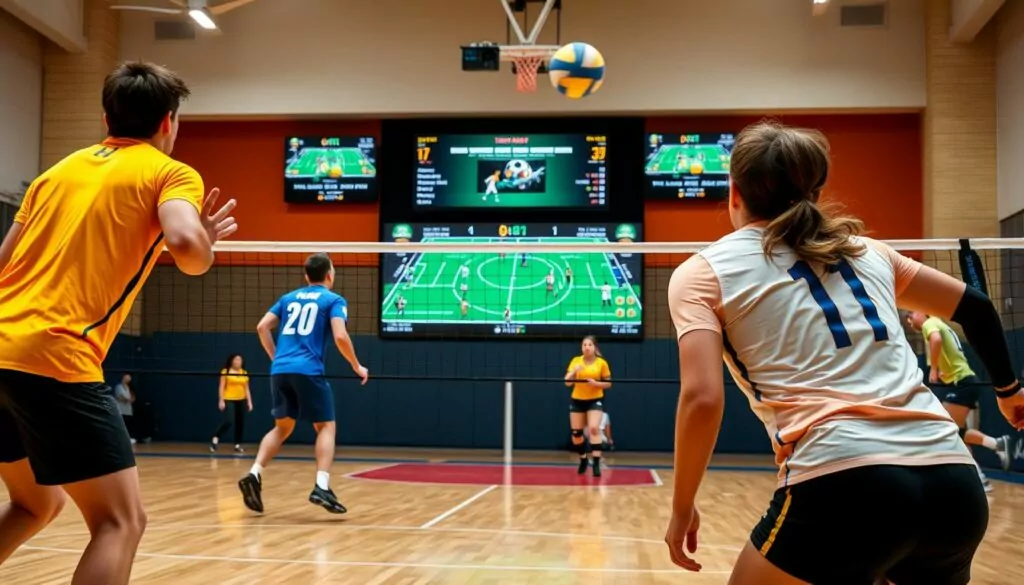
As a volleyball player, it’s key to watch and study your opponent’s moves. Look at their serve receive, attack, and defense patterns. This helps you find ways to beat their strong points.
Observing Patterns during Play
Watch your opponents closely during the game. See how they line up for serves and where their best hitters are. Also, notice their defense setup. This info lets you spot their weak spots and plan your moves.
Adjusting My Strategy in Real-Time
After observing, be ready to change your game plan. You might need to aim your serves differently, change your attack, or shift your defense. Being flexible and quick to adapt is essential to outsmarting your opponents.
“The ability to quickly analyze and adjust to your opponent’s tactics is a hallmark of successful volleyball teams.” – Michael Johnson, Volleyball Coaching Strategist
Volleyball is like a chess game, with teams constantly trying to outmaneuver each other. By being alert, analyzing your opponents, and adjusting fast, you can get ahead and help your team win.
Transitioning from Defense to Offense
Switching from defense to offense is key in volleyball. Players can surprise opponents by quickly going from defense to attack. This can lead to scoring chances. To do this well, mastering quick set plays and counterattacks is important.
Quick Set Plays
Quick sets are about fast, low sets to hitters. This surprises the defense and lets attackers swing freely. Good footwork and timing are key for quick sets.
Counterattacks Explained
Counterattacks start right after defense, catching the other team off guard. They need quick thinking and good ball control. This way, players can take control of the game.
Being good at volleyball transitions, quick sets, and counterattacks is key to winning. Regular drills help improve footwork, timing, and decision-making. This makes players quick to switch from defense to offense.
| Drill | Description | Key Benefits |
|---|---|---|
| Pull Drill | Six hitters participate in the drill, repeating the same pattern of transition 12 times. | Improves footwork and coordination during transitions. |
| Team Transition Drill | Six players set up in base defense on side A, continuing the sequence of ball contacts for 10 balls. Side B players can rotate. | Enhances game-like transition skills and awareness. |
“Transition footwork can serve as an excellent volleyball conditioning drill, improving players’ agility and coordination.”
The Role of Teamwork in Volleyball Success
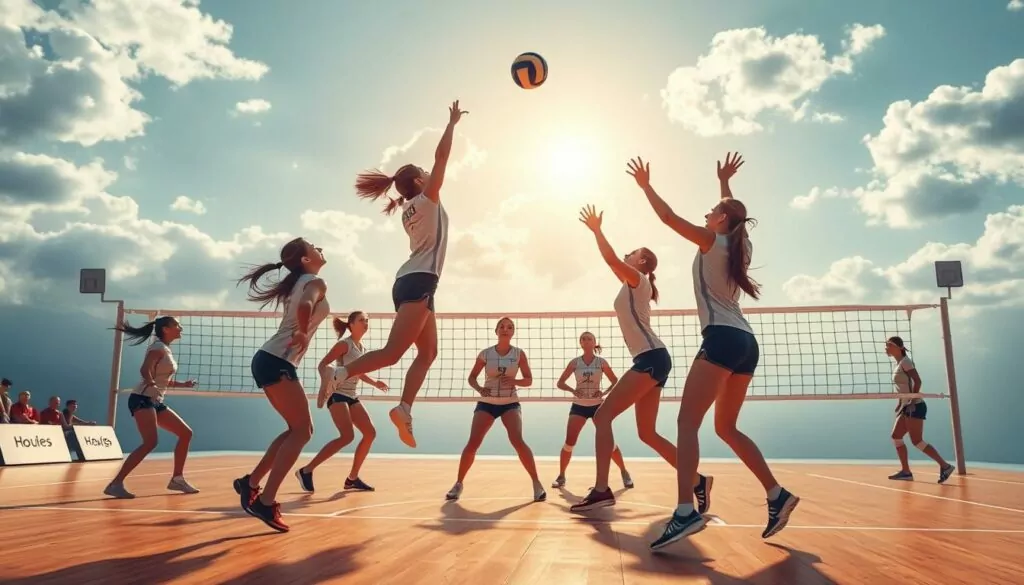
Volleyball is a team sport where teamwork is key. Players must work together smoothly. This teamwork is what makes serves, passes, sets, and spikes successful. It leads to scoring points and winning games.
Building Team Chemistry
Strong team chemistry is vital in volleyball. It’s about trust, open communication, and a shared goal. When teammates trust and know each other’s strengths and weaknesses, they can react better to game situations.
Coordinating With Setters and Hitters
Good player coordination is essential, mainly between setters and hitters. Setters need to set clear timing and preferences for hitters. Hitters should communicate their readiness and preferred set heights. This coordination helps the team execute complex plays and score more.
Team-building activities and clear communication during practice and games improve volleyball teamwork. When players are in sync, they can handle game changes, solve problems, and dominate the court.
“Volleyball is a team sport, and the team that executes the best teamwork and communication will usually win.” – John Wooden, legendary basketball coach
Utilizing the Block to Your Advantage

Blocking is key in volleyball, needing both anticipation and timing. As a blocker, your main goal is to stop the opposing team’s attack. This is done by positioning yourself right and jumping at the perfect time. Learning to block well can really upset the other team’s game plan and give you an edge.
Techniques for Effective Blocking
There are a few ways to block better. One method is penetration, where you stretch over the net to block the ball. Another is sealing, which means getting close to your teammates to form a strong wall. You can also use angle or line blocking to limit the hitter’s options.
Tips for Reading Opponent’s Hits
To block well, you need to read the hitter’s moves. Watch how they approach, swing their arms, and stand to guess where they’ll hit. This skill, called “reading hits,” helps you move fast and get into the right spot. Getting practice against different hitters and styles will improve this skill.
Remember, blocking in volleyball is more than just being tall. It’s about knowing when to jump, understanding the hitter’s moves, and being quick. By learning these techniques, you’ll become a top player at the net, stopping your opponents and helping your team win.
“The art of blocking is about more than just jumping high; it’s about reading the hitter, anticipating their move, and timing your jump to perfection.”
Conditioning and Physical Preparedness
Volleyball is a fast-paced sport that needs explosive power, agility, and endurance. As a player, staying fit is key to doing well on the court. Good conditioning boosts your performance and keeps you safe from injuries that could keep you out of big games.
Importance of Fitness in Volleyball
Volleyball needs quick energy and long-lasting stamina. Interval training and long-distance running boost your heart health. They help you play at top speed all game long. Also, low-impact activities like cycling and swimming are great for fitness without hurting your joints.
Recommended Exercises for Players
- Strength training: Squats, deadlifts, and plyometric drills boost jumping and arm strength.
- Agility training: Agility ladders, cones, and interval running make you quicker and more agile on the court.
- Flexibility and stability: Dynamic stretching and core exercises keep you flexible and in control.
Adding volleyball-specific moves to your workout makes you stronger and more flexible for the game. Being consistent with your fitness is essential. Regular workouts and a balanced fitness plan will help you perform at your best and stay healthy all season.
| Fitness Component | Recommended Exercises | Benefits |
|---|---|---|
| Strength | Squats, Deadlifts, Plyometrics | Improved jumping power and arm strength |
| Agility | Agility Ladders, Cone Drills, Interval Running | Enhanced on-court mobility and reflexes |
| Flexibility and Stability | Dynamic Stretching, Core Exercises | Optimal range of motion and control on the court |
By focusing on conditioning, you’ll not only get better at volleyball but also avoid injuries. Staying dedicated to a balanced fitness plan is the secret to excelling in the game and reaching your highest level as a player.
Mental Strategies for Competitive Play
Being a volleyball player means you need to prepare your mind as much as your body. Staying calm and focused can make all the difference. Learning key mental strategies can give you an edge on the court.
Staying Focused Under Pressure
It’s hard to keep your mind on the game when the crowd is loud and the stakes are high. Use performance cue strategies to keep your focus. These can be reminders to pay attention to your footwork or how you hit the ball. Also, focus on one point at a time to stay in the moment and avoid getting stressed about the game’s outcome.
Visualization Techniques
Visualization is a strong tool for volleyball players. It helps you practice winning plays and handling tough situations in your mind. Before a game, take a few minutes to imagine yourself:
- Perfectly serving or attacking
- Anticipating and blocking a strong hit
- Working well with your teammates
Adding mindfulness and concentration exercises to your training can also help. They keep you calm and focused during intense moments in games.
“Every athlete is nervous before a game, and can decide how to interpret the pre-game jitters to improve performance.”
By learning mental preparation, you can reach your full volleyball ability. You’ll be ready to perform your best when it counts.
Analyzing Game Footage for Improvement
Looking at game footage can really help you get better at volleyball. You can see what you and your team do well and what you need to work on. It also helps you understand your opponents and make smarter choices during games.
Benefits of Reviewing Past Matches
Watching volleyball footage can open up many chances for you to grow. Some main benefits are:
- Spotting areas where you can get better technically and tactically
- Learning your opponents’ moves and finding their weak spots
- Improving your decision-making by thinking about key moments
- Working better as a team by analyzing together
- Seeing how you and your team have improved over time
Things to Look for in Footage
When you watch game footage, pay attention to a few key things:
- Positioning: See where you and your teammates are and how it affects your play.
- Timing: Check how well you time your moves, like getting to the net or jumping.
- Technique: Look closely at how you perform skills like serving, passing, setting, and attacking.
- Tactical Decisions: Think about the choices you and your teammates make during the game.
By focusing on these areas, you can find your strong points and what you need to improve. Use this info to make your training better and come up with new strategies for your next game.
Using video analysis in volleyball is a great way to improve. It gives you important insights and helps you do better in your games.
Practice Drills to Enhance Skills
As a volleyball fan, I’ve found that different drills can really boost your skills. Whether you’re a libero working on defense or an attacker improving your hitting, drills are key. Let’s look at some drills that can elevate your game.
Key Drills for Liberos
Liberos need to work on quick reactions and accurate passing. Drills like the rapid-fire dig practice and serve receive drills are great. They help players react fast and improve their body positioning and footwork.
Diving drills are also vital for liberos. They help develop agility and bravery for making key plays. Adding these drills to your routine can make you a strong defender.
Hitting Drills for Attackers
Attackers need to master hitting basics. Drills on approach footwork, arm swing, and targeted hitting are essential. Approach footwork drills help players move well and time their jumps. Arm swing exercises focus on hand contact and follow-through.
Target hitting practice is also great for attackers. It helps them aim for specific spots on the court and improve their scoring precision.
Consistent practice is the secret to mastering these skills. By doing a variety of drills, you can improve your volleyball game and lead your team to victory.
“Volleyball is a game of constant motion, and the more you can train your body to react quickly and efficiently, the better you’ll perform on the court.” – Coach Karen
Keeping Up with Trends in Volleyball
I love volleyball and always want to know the latest trends and innovations. The sport is always changing, with new training methods and competitive strategies. It’s important to stay updated to stay ahead.
Innovations in Training Techniques
Technology has changed volleyball training a lot. Wearable devices track heart rate, jump height, and speed. This helps players and coaches tailor training to each person.
Virtual Reality (VR) and Augmented Reality (AR) are also big in training. They let players practice game scenarios in a real way. This prepares them for the pressure of competition.
Emerging Strategies in Competitive Volleyball
New strategies are making volleyball more exciting. Artificial Intelligence (AI) helps teams analyze opponents quickly. This lets them change their game plan fast.
New volleyball gear is also changing the game. Smart volleyballs and shoes that adjust to movement are just a few examples. These innovations make the game more dynamic.
Fan engagement is getting a boost too. Digital platforms and AR experiences make watching volleyball more fun. Fans get a closer, more interactive experience.
